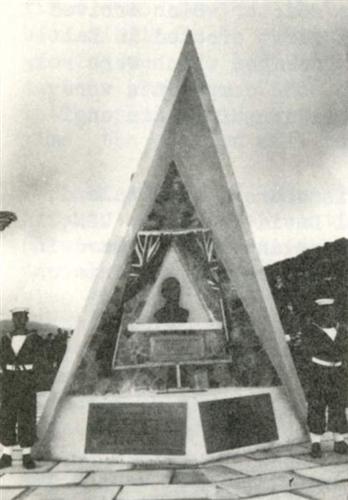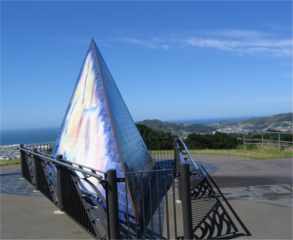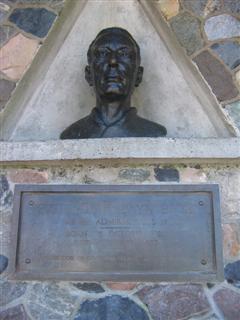|
On 11 March 1962, the fifth anniversary of the Admiral's death, the New Zealand National Memorial to Rear Admiral Richard E. Byrd was dedicated at Wellington. The Reverend W. E. D. Davies, chairman of the Wellington Branch of the National Council of Churches, performed the dedication, and the Right Honorable Keith Holyoake, Prime Minister of New Zealand, assisted by Rear Admiral David M. Tyree and Mr. A. Leigh Hunt, originator of the project, unveiled the bust of Admiral Byrd which is in the center of the memorial. The response to the dedication was made by Miss Ruth Bacon, United States Charge d'Affaires. The honored guest and representative of the Byrd family was Mrs. Robert Breyer, the late Admiral's daughter.
In addition to the Prime Minister, the leader of the opposition, the Right Honorable Walter Nash, and the dean of the diplomatic corps, His Excellency Admiral Sir John Collins [sic--Admiral Collins was actually the Australian High Commissioner in New Zealand--Bill], made brief addresses. Mr. Tracey Simpson, chairman of the Richard E. Byrd Fellowship, which sponsored the memorial, read messages from prominent persons all over the world. Among them was one from President Kennedy which said in part that the memorial to Admiral Byrd would stand "as a symbol of enduring friendship between the United States, land of his birth, and New Zealand, the country with which he was so closely associated in his great adventures."
The memorial recognizes not only Admiral Byrd's accomplishments in exploration, referring to him as the "greatest explorer of the air age," but also his contributions to international understanding. One large plaque refers to him as "a great internationalist," whose "concepts of Antarctica as 'the great white continent of peace' are contained in the Antarctic Treaty."
 The above article and photo were published in the Bulletin of the U. S, Antarctic Projects Officer, March, 1962. The memorial was constructed at the Mt. Victoria lookout, east of the city center. The bronze bust of Admiral Byrd was sculpted by Thomas V. Johnston. Byrd's head is looking south; the stones on the south-facing wall--perhaps a half ton of them--came from the Koettlitz Glacier and Ross Island areas of Antarctica. The sides of the memorial were originally white stucco. Wellington mayor Frank Kitts, Christchurch mayor George Manning, the Bishop of Christchurch Edward Joyce, and the chairman of the Christchurch branch of the New Zealand Antarctic Society also participated in the dedication.
ther honored guests included three members of Scott's Terra Nova expedition--Mortimer McCarthy (able seaman), William Burton (leading stoker, Royal Navy), and William McDonald (able seaman). These men all were living in or near Christchurch at the time. Also present was Edward E. Goodale--a member of Byrd's 1928-30 expedition and the USARP Christchurch representative from 1959 to 1968, as well as NSF polar researcher Philip M. Smith. The above article and photo were published in the Bulletin of the U. S, Antarctic Projects Officer, March, 1962. The memorial was constructed at the Mt. Victoria lookout, east of the city center. The bronze bust of Admiral Byrd was sculpted by Thomas V. Johnston. Byrd's head is looking south; the stones on the south-facing wall--perhaps a half ton of them--came from the Koettlitz Glacier and Ross Island areas of Antarctica. The sides of the memorial were originally white stucco. Wellington mayor Frank Kitts, Christchurch mayor George Manning, the Bishop of Christchurch Edward Joyce, and the chairman of the Christchurch branch of the New Zealand Antarctic Society also participated in the dedication.
ther honored guests included three members of Scott's Terra Nova expedition--Mortimer McCarthy (able seaman), William Burton (leading stoker, Royal Navy), and William McDonald (able seaman). These men all were living in or near Christchurch at the time. Also present was Edward E. Goodale--a member of Byrd's 1928-30 expedition and the USARP Christchurch representative from 1959 to 1968, as well as NSF polar researcher Philip M. Smith.
In the early 1990s the monument was refurbished, and the sides, which originally had been white stucco, were reclad with ceramic tiles depicting auroras, by artist Doreen Blumhardt. The plaques were replaced, and a new stone plaque was added commemorating Paul Siple. The memorial was rededicated on 21 June 1993.
The dedication photo at left is from the June 1962 Antarctic, (journal of the New Zealand Antarctic Society)...originally from the Wellington newspaper Dominion.
The photographs and text captures below are mine, from a January 2004 visit. A later restoration was completed on 21 November 2007.
|
THE ANTARCTIC TREATY
Signed on 1 December 1959 by twelve nations, this was a milestone along the road to international co-operation. It provided for non-militarisation, for the prevention of nuclear explosions and the disposal of radioactive waste, for an international inspection system, for the pooling of scientific information. It demonstrated the subordination of national interests to the wider cause of science and increased understanding between nations.
|
THE GREATEST EXPLORER OF THE AIR AGE
Richard Evelyn Byrd dedicated his life to peaceful progress for mankind. Outstanding in aviation and exploration; he was a scientist, a humanitarian, a champion of freedom and a great internationalist. His concept of Antarctica as "the great white continent of peace" was a prelude to the Antarctic Treaty.
May the spirit of the Treaty endure and spread throughout the world.
|






